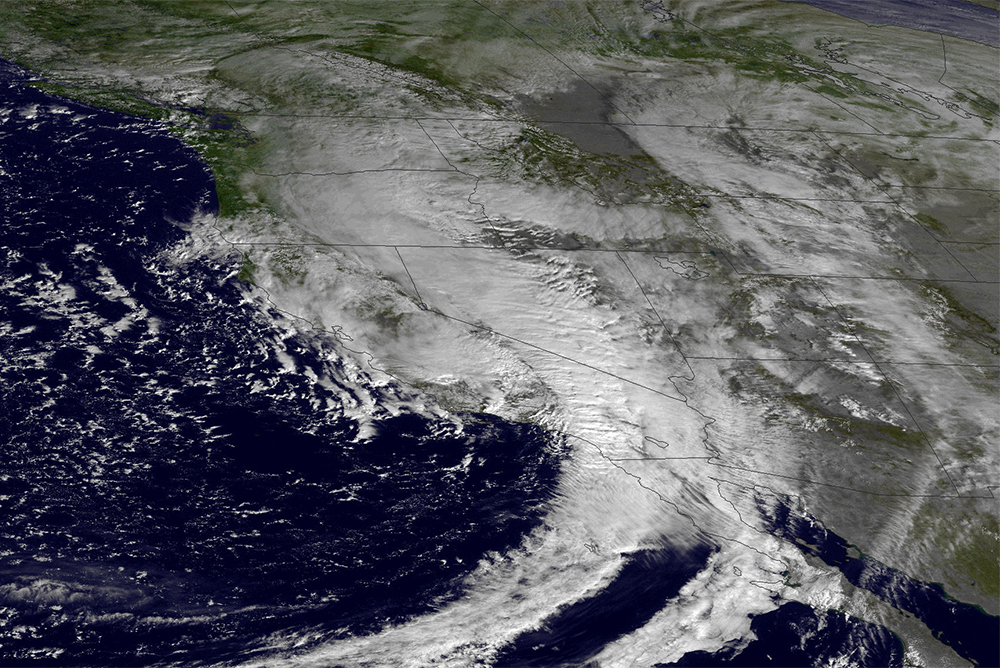
Why is it so hard to make seasonal weather predictions in California—and what’s the path to more accurate forecasts? Columnist Joe Mathews asks in the latest Connecting California. Satellite image courtesy of NOAA Photo Library/Flickr (CC BY 2.0 DEED).
California weather is harder to predict than it looks. Even Harris K. Telemacher came to learn that.
Telemacher was a Los Angeles TV weathercaster with an ocean of knowledge—he had a PhD in arts and humanities and quoted Shakespeare—but no real meteorological training. So, he assumed that California weather was predictable and decided to tape his televised forecasts weeks in advance, always promising sunny and warm days. This worked until an unexpected Pacific storm deluged the Southland during one of his pre-recorded forecasts.
Telemacher was a fictional character invented and inhabited by Steve Martin in the classic satire L.A. Story. But he embodied a real-life cliché that needs retiring.
California weather has never been as predictable as a Steve Martin gag—especially when it comes to the rain and snow of Golden State winters like this one.
In fact, no state in the lower 48 sees as much variability in its year-to-year precipitation as California. Such variability makes our weather at least as unpredictable as anything else in this volatile state. Last year, California was in the midst of the driest three-year run in recorded history when NOAA, the National Oceanic and Atmospheric Administration, published a seasonal forecast for a drier-than-average winter. Instead, we experienced one of our wettest winters ever.
Now, another winter of weather surprises has arrived, demonstrating that California desperately needs better seasonal forecasts so we can plan and protect ourselves in this era of climate change.
Seasonal forecasts are not the predictions of tomorrow’s weather that you see delivered on your TV by Telemacher and his present-day imitators. Seasonal forecasts provide a range of possible weather and climate changes for the next season on the calendar, usually about a month or so in advance. (Federal agency forecasts for winter are usually out by Halloween.) Meteorologists will tell you that while it’s impossible to tell you the weather on a particular day months in advance, they should be able to predict, broadly, how wet or dry the next season should be.
But that’s always been hard to do in California. Lately, it’s become even harder because of the state’s “weather whiplash”—the term that the Public Policy Institute of California has used in recent years to describe the seesawing we’ve seen between flood and drought.
Our current inability to predict seasonal wet conditions makes it harder to manage water supplies (we need to store more in wet winters to prepare for drier years), prepare for disasters (including unpredictable floods, like the one that recently inundated San Diego), and do long-term economic planning for agriculture, which supplies food to the entire nation.
It’s not just winter weather that’s hard to foresee. Predicting scorching heat, as the state’s daily average maximum temperature rises by more than 4 degrees, is difficult. Impactful heat waves, called Heat Health Events, are expected to increase in frequency and duration, especially in the Central Valley and Sierra. Calling those ahead of time could be a matter of life and death.
But improving seasonal forecasts is easier said than done. Even the most advanced meteorologists have struggled with making seasonal forecasts. Indeed, recent studies, now getting attention in California policy circles, suggest that our state and its meteorologists need a better understanding of the peculiarities of the Pacific Ocean to improve their forecasts.
Making expectations about how much rain or snow is likely to fall in California depends on predicting atmospheric patterns over the northern Pacific Ocean. To do so, meteorologists have tended to look at sea surface temperatures in the South Pacific and the phenomena known as El Niño and La Ninã. Warm temperatures, or “El Niño” conditions, were believed to herald rain. Cool “La Niña” conditions were thought to signal a dry winter.
But a recent paper highlighted by PPIC, with authors from UCLA and the Jet Propulsion Laboratory, found that El Niño conditions don’t explain most of the variability of our weather. To cite one example, tropical sea surface temperatures and conditions were very similar in 2021–22 and 2022–23, but the first winter was dry and the second was one of the wettest in history.
“It remains elusive how predictable the year-to-year variability of CA winter precipitation is and why it is challenging to achieve skillful seasonal prediction of CA precipitation,” the paper said.
According to its authors, to arrive at more accurate seasonal forecasts, scientists need a better understanding of the ocean’s “circulation anomalies,” which are deviations in averages and expected conditions independent of El Niño. Current climate models, the paper argued, “show nearly no skill in predicting these,” which means that they have “limited predictive skill for California winter precipitation.”
The paper also argued that current climate models can’t predict patterns that stem from tropical convection (i.e. tropical clouds and thunderstorms) or the stratospheric polar vortex. This means that for better seasonal forecasts, meteorologists need a better understanding of conditions and patterns not only in the relatively nearby western Pacific but also in waters as far away as the Indian and Arctic oceans.
How do we achieve this?
One answer is to devote more time and resources to observing oceans, sea ice, and clouds—and their impacts on precipitation. Another answer is to employ better computer capacity and artificial intelligence to build better climate models. This is a planetary problem—if you want better predictions of California precipitation, you need to improve modeling and data for the climate of the whole earth.
But such improvements won’t happen fast. So, for at least a few more winters, we’re stuck with unreliable seasonal forecasts and unpredictable weather.




Send A Letter To the Editors